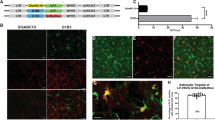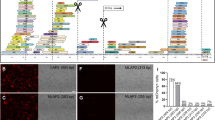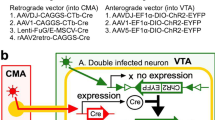Abstract
Ex vivo gene transfer to the CNS has so far been hampered by instability of transgene expression. To avoid the phenomenon of transgene down-regulation, we have employed strong, constitutive promoters and compared this expression system with the inducible Tet expression system incorporated in a single plasmid vector or in lentiviral vectors. Plasmid-based transgene expression directed by the constitutive, human ubiquitin promoter, UbC, was stable in transfected HiB5 cells in vitro and comparable in strength to the CMV promoter. However, after transplantation of UbC and CMV HiB5 clones to the rat striatum, silencing of the transgene occurred in most cells soon after implantation of transfected cells. The Tet-on elements were incorporated in a single plasmid vector and inducible HiB5 clones were generated. Inducible clones displayed varying basal expression activity, which could not be ascribed to an effect of cis-elements in the vector, but rather was due, at least in part, to intrinsic activity of the minimal promoter. Basal expression activity could be blocked in a majority of cells by stable expressing the transrepressor tTS. Fully induced expression levels were comparable to CMV and UbC promoters. Similar to the constitutive promoters transgene expression was down-regulated soon after grafting of inducible HiB5 clones to the rat striatum. Lentiviral vectors can direct long-term stable in vivo transgene expression. To take advantage of this quality of the lentiviral vector, the Tet-on elements were incorporated in two lentiviral transfer vectors followed by transduction of Hib5 cells. Interestingly, all HiB5 clones established by lentiviral transduction showed very similar expression patterns and tight regulatability that apparently was independent of transgene copy number and integration site. Nevertheless, transgene expression in all lentiviral HiB5 clones was down-regulated shortly after transplantation to the rat striatum. These results confirm the general phenomenon of transgene down-regulation. Moreover, the results suggest that the considerable advantages offered by lentiviral vectors for direct gene delivery cannot necessarily be transferred directly to ex vivo gene delivery. This emphasizes the need for alternative vector strategies for ex vivo gene transfer.
This is a preview of subscription content, access via your institution
Access options
Subscribe to this journal
Receive 12 print issues and online access
$259.00 per year
only $21.58 per issue
Buy this article
- Purchase on Springer Link
- Instant access to full article PDF
Prices may be subject to local taxes which are calculated during checkout





Similar content being viewed by others
References
Costantini LC, Bakowska JC, Breakefield XO, Isacson O . Gene therapy in the CNS Gene Therapy 2000 7: 93–109
Lundberg C, Horellou P, Mallet J, Bjorklund A . Generation of DOPA-producing astrocytes by retroviral transduction of the human tyrosine hydroxylase gene: in vitro characterization and in vivo effects in the rat Parkinson model Exp Neurol 1996 139: 39–53
Quinonero J et al. Gene transfer to the central nervous system by transplantation of cerebral endothelial cells Gene Therapy 1997 4: 111–119
Yoshimoto Y et al. Astrocytes retrovirally transduced with BDNF elicit behavioral improvement in a rat model of Parkinson's disease Brain Res 1995 691: 25–36
Schorpp M et al. The human ubiquitin C promoter directs high ubiquitous expression of transgenes in mice Nucleic Acids Res 1996 24: 1787–1788
Johansen TE, Scholler MS, Tolstoy S, Schwartz TW . Biosynthesis of peptide precursors and protease inhibitors using new constitutive and inducible eukaryotic expression vectors FEBS Lett 1990 267: 289–294
Gossen M, Bujard H . Tight control of gene expression in mammalian cells by tetracycline-responsive promoters Proc Natl Acad Sci USA 1992 89: 5547–5551
Gossen M, Bujard H . Tight control of gene expression in mammalian cells by tetracycline-responsive promoters Hermann Bujard's Home Page:www.zmbh.uni-heidelberg.de/Bujard/Homepage.html.
Kafri T, van Praag H, Gage FH, Verma IM . Lentiviral vectors: regulated gene expression Mol Ther 2000 1: 516–521
Blomer U et al. Highly efficient and sustained gene transfer in adult neurons with a lentivirus vector J Virol 1997 71: 6641–6649
Harding TC et al. Switching transgene expression in the brain using an adenoviral tetracycline-regulatable system Nat Biotechnol 1998 16: 553–555
Bohl D, Naffakh N, Heard JM . Long-term control of erythropoietin secretion by doxycycline in mice transplanted with engineered primary myoblasts Nat Med 1997 3: 299–305
Renfranz PJ, Cunningham MG, McKay RD . Region-specific differentiation of the hippocampal stem cell line HiB5 upon implantation into the developing mammalian brain Cell 1991 66: 713–729
Englund U et al. The use of a recombinant lentiviral vector for ex vivo gene transfer into the rat CNS Neuroreport 2000 11: 3973–3977
Lundberg C et al. Survival, integration, and differentiation of neural stem cell lines after transplantation to the adult rat striatum Exp Neurol 1997 145: 342–360
Freundlieb S, Schirra-Muller C, Bujard H . A tetracycline controlled activation/repression system with increased potential for gene transfer into mammalian cells J Gene Med 1999 1: 4–12
Meyer M et al. Improved survival of embryonic porcine dopaminergic neurons in coculture with a conditionally immortalized GDNF-producing hippocampal cell line Exp Neurol 2000 164: 82–93
Clackson T . Regulated gene expression systems Gene Therapy 2000 7: 120–125
Gossen M et al. Transcriptional activation by tetracyclines in mammalian cells Science 1995 268: 1766–1769
Yin DX, Zhu L, Schimke RT . Tetracycline-controlled gene expression system achieves high-level and quantitative control of gene expression Anal Biochem 1996 235: 195–201
Garrick D, Fiering S, Martin DI, Whitelaw E . Repeat-induced gene silencing in mammals Nat Genet 1998 18: 56–59
Bujard H et al. Insertion of transcriptional elements outside the replication region can interfere with replication, maintenance, and stability of Co1E1-derived plasmids Basic Life Sci 1985 30: 45–52
Hoffmann A, Villalba M, Journot L, Spengler D . A novel tetracycline-dependent expression vector with low basal expression and potent regulatory properties in various mammalian cell lines Nucleic Acids Res 1997 25: 1078–1079
Steinwaerder DS, Lieber A . Insulation from viral transcriptional regulatory elements improves inducible transgene expression from adenovirus vectors in vitro and in vivo Gene Therapy 2000 7: 556–567
Martinez-Serrano A, Fischer W, Bjorklund A . Reversal of age-dependent cognitive impairments and cholinergic neuron atrophy by NGF-secreting neural progenitors grafted to the basal forebrain Neuron 1995 15: 473–484
Liu Y et al. Transplants of fibroblasts genetically modified to express BDNF promote regeneration of adult rat rubrospinal axons and recovery of forelimb function J Neurosci 1999 19: 4370–4387
Naldini L et al. In vivo gene delivery and stable transduction of nondividing cells by a lentiviral vector Science 1996 272: 263–267
Gao Z et al. High levels of transgene expression following transduction of long-term nod/scid-repopulating human cells with a modified lentiviral vector Stem Cells 2001 19: 247–259
Gallichan WS et al. Lentivirus-mediated transduction of islet grafts with interleukin 4 results in sustained gene expression and protection from insulitis Hum Gene Ther 1998 9: 2717–2726
Szyf M . The DNA methylation machinery as a target for anticancer therapy Pharmacol Ther 1996 70: 1–37
Siegfried Z et al. DNA methylation represses transcription in vivo Nat Genet 1999 22: 203–206
Chen WY et al. Reactivation of silenced, virally transduced genes by inhibitors of histone deacetylase Proc Natl Acad Sci USA 1997 94: 5798–5803
Tsai DJ, Ho JJ, Ozawa CR, Sapolsky RM . Long-term expression driven by herpes simplex virus type-1 amplicons may fail due to eventual degradation or extrusion of introduced transgenes Exp Neurol 2000 165: 58–65
Pikaart MJ, Recillas-Targa F, Felsenfeld G . Loss of transcriptional activity of a transgene is accompanied by DNA methylation and histone deacetylation and is prevented by insulators Genes Dev 1998 12: 2852–2862
Rivella S et al. The cHS4 insulator increases the probability of retroviral expression at random chromosomal integration sites J Virol 2000 74: 4679–4687
Chung JH, Whiteley M, Felsenfeld G . A 5’ element of the chicken beta-globin domain serves as an insulator in human erythroid cells and protects against position effect in Drosophila Cell 1993 74: 505–514
Jordan A, Defechereux P, Verdin E . The site of HIV-1 integration in the human genome determines basal transcriptional activity and response to Tat transactivation EMBO J 2001 20: 1726–1738
Zufferey R, Donello JE, Trono D, Hope TJ . Woodchuck hepatitis virus posttranscriptional regulatory element enhances expression of transgenes delivered by retroviral vectors J Virol 1999 73: 2886–2892
von Schwedler U, Song J, Aiken C, Trono D . Vif is crucial for human immunodeficiency virus type 1 proviral DNA synthesis in infected cells J Virol 1993 67: 4945–4955
von Schwedler U, Song J, Aiken C, Trono D . Vif is crucial for human immunodeficiency virus type 1 proviral DNA synthesis in infected cells Brown T. Southern blotting. In: Ausubel et al (eds). Current Protocols in Molecular Biology. John Wiley & Sons: NY, 2001, pp 2.9.1–2.9.15.
Rosenblad C et al. Protection and regeneration of nigral dopaminergic neurons by neurturin or GDNF in a partial lesion model of Parkinson's disease after administration into the striatum or the lateral ventricle Eur J Neurosci 1999 11: 1554–1566
Kirik D, Rosenblad C, Bjorklund A, Mandel RJ . Long-term rAAV-mediated gene transfer of GDNF in the rat Parkinson's model: intrastriatal but not intranigral transduction promotes functional regeneration in the lesioned nigrostriatal system J Neurosci 2000 20: 4686–4700
Sauer H, Oertel WH . Progressive degeneration of nigrostriatal dopamine neurons following intrastriatal terminal lesions with 6-hydroxydopamine: a combined retrograde tracing and immunocytochemical study in the rat Neuroscience 1994 59: 401–415
Acknowledgements
We appreciate the excellent technical support from Birgitte Romme Larsen and Ulla Jarl. We thank D Trono for the generous gift of the lentiviral vector system.
Author information
Authors and Affiliations
Rights and permissions
About this article
Cite this article
Johansen, J., Rosenblad, C., Andsberg, K. et al. Evaluation of Tet-on system to avoid transgene down-regulation in ex vivo gene transfer to the CNS. Gene Ther 9, 1291–1301 (2002). https://doi.org/10.1038/sj.gt.3301778
Received:
Accepted:
Published:
Issue Date:
DOI: https://doi.org/10.1038/sj.gt.3301778
Keywords
This article is cited by
-
Design of a Lentiviral Vector for the Inducible Expression of MYC: A New Strategy for Construction Approach
Molecular Biotechnology (2017)
-
Spontaneous recombinase activity of Cre–ERT2 in vivo
Transgenic Research (2017)
-
Lentiviral Vectors in Gene Therapy: Their Current Status and Future Potential
Archivum Immunologiae et Therapiae Experimentalis (2010)
-
Comparison of Optical Bioluminescence Reporter Gene and Superparamagnetic Iron Oxide MR Contrast Agent as Cell Markers for Noninvasive Imaging of Cardiac Cell Transplantation
Molecular Imaging and Biology (2009)
-
Lentiviral vectors for cancer immunotherapy: transforming infectious particles into therapeutics
Gene Therapy (2007)



